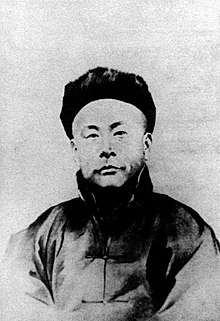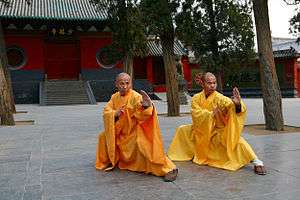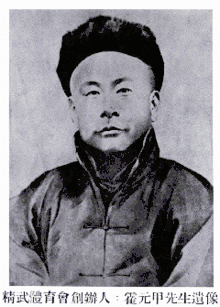Huo Yuanjia
Huo Yuanjia (18 January 1868 – 9 August 1910),[1] courtesy name Junqing, was a Chinese martial artist and a co-founder of the Chin Woo Athletic Association, a martial arts school in Shanghai. A practitioner of the martial art mizongyi,[2] Huo is considered a hero in China for defeating foreign fighters in highly publicised matches at a time when Chinese sovereignty was being eroded by foreign imperialism, concessions and spheres of influence. Due to his heroic status, the legends and myths surrounding events in his life are difficult to discern from facts.[3]
| Huo Yuanjia | |||||||||||||
|---|---|---|---|---|---|---|---|---|---|---|---|---|---|
 Huo Yuanjia | |||||||||||||
| Born | 18 January 1868 Xiaonanhe Village, Jinghai County, Tianjin, Qing China | ||||||||||||
| Died | 9 August 1910 (aged 42) Shanghai, Qing China arsenic poisoning | ||||||||||||
| Native name | 霍元甲 | ||||||||||||
| Style | Wushu Mizongyi | ||||||||||||
| Teacher(s) | Chen Seng-ho Huo Endi | ||||||||||||
| Occupation | Martial artist | ||||||||||||
| Spouse | Ms. Wang ( m. before 1910) | ||||||||||||
| Children | 5 | ||||||||||||
| Notable relatives | Huo Endi (father) | ||||||||||||
| Notable club(s) | Chin Woo Athletic Association | ||||||||||||
| Chinese name | |||||||||||||
| Chinese | 霍元甲 | ||||||||||||
| |||||||||||||
| Junqing (courtesy name) | |||||||||||||
| Chinese | 俊卿 | ||||||||||||
| |||||||||||||
| Part of a series on |
| Chinese martial arts (Wushu) |
|---|
 |
| Wushu in the world |
|
Historical locations
|
| Wushu athletes/practitioners |
|
Legendary figures
|
|
Historical individuals
|
|
Modern celebrities
|
| Wushu influence |
Early life
Huo was born in Xiaonanhe Village in Jinghai County, Tianjin, as the fourth of Huo Endi's ten children. The family's main source of income was from agriculture, but Huo Endi also made a living by escorting merchant caravans to Manchuria and back. Although he was from a family of traditional wushu practitioners, Huo was born weak and susceptible to illness. He had asthma and, at an early age, he contracted jaundice, which would recur periodically for the rest of his life. It is theorised that he may have had a mild form of congenital jaundice known as Gilbert's syndrome. Due to his frail frame, his father discouraged him from learning wushu.
Huo Endi hired Chen Seng-ho, a tutor from Japan, to teach his son academics and moral values. In return, Chen was taught the Huo family's style of martial arts, mizongyi. Huo still desired to learn wushu, against his father's wishes, so he observed his father teaching his students martial arts in the day and secretly practised at night with Chen.
In 1890, a martial artist from Henan visited the Huo family and fought with Huo's elder brother, who lost. To the surprise of his family, Huo fought with his brother's opponent and defeated the latter. As Huo proved that he was physically able to practise wushu, his father accepted him as a student. As he became older, Huo went on to challenge martial artists from neighbouring areas and his fame grew as he defeated more opponents in bouts.
Huo joined his father at work as a caravan guard. One day, while escorting a group of monks, Huo was confronted by a group of bandits, who threatened to attack the monks. Huo fought the bandit chief and defeated him. News of his feat spread and added on to his growing fame. In 1896, Huo went to Tianjin and made a living there by working as a porter in the Huaiqing pharmacy and by selling firewood.
Rise to fame
In 1902, Huo responded to a challenge advertised by a Russian wrestler in Xiyuan Park, Tianjin. The wrestler openly called the Chinese "sick men of Asia" because no one accepted his challenge to a fight. The Russian forfeited when Huo accepted his challenge and told Huo that he was merely putting on a performance to make a living and apologised for his earlier remark in the newspaper.[4]
Between 1909 and 1910, Huo travelled to Shanghai twice to accept an open challenge posed by an Irish boxer, Hercules O'Brien. The two of them had arguments over the rules governing such boxing matches and eventually agreed that whoever knocked down his opponent would be the victor. O'Brien fought Huo and lost. Huo's victory was a great inspiration to the Chinese people and had them questioning the basis of imperialistic dominance. However, there is a lot of controversy over whether the fight ever took place. A recent article states that O'Brien[5] opted to leave town instead.[4]
Chin Woo Athletic Association

Between 1909 and 1910,[6] Huo founded the Chin Woo Physical Training Centre (精武体操会) (later renamed to "Chin Woo Athletic Association") with his close friend Nong Jinsun, who served as the president of the association.[7] Huo was encouraged by his close friends and was sponsored by Sun Yat-sen and Song Jiaoren, who were living in Tokyo. The centre was meant to be a school for learning the arts of self-defence and improvement of health and mind.
Huo suffered from jaundice and tuberculosis and started seeing a Japanese physician for medication and treatment. The physician, who was a member of the Japanese Judo Association in Shanghai, invited Huo to a competition upon hearing of the latter's fame. Huo's student, Liu Zhensheng, competed with a judo practitioner. Although there were disputes over who won the match, both sides generally agreed that the disagreement culminated in a brawl and that members of the judo team were injured, some with broken fingers and hands, including the head instructor.
Death
Huo died in 1910 at the age of 42. He was survived by his wife Ms. Wang (王氏; given name unknown) (1869?–1960), two sons Huo Dongzhang (霍東章) and Huo Dongge (霍東閣), and three daughters Huo Dongru (霍東茹), Huo Dongling (霍東玲) and Huo Dongqin (霍東琴).[8]
The historian Chen Gongzhe, who was also one of Huo's students, believed that the cause of his master's death was hemoptysis disease. Chen wrote that Huo was introduced to a Japanese physician by the judo instructor as his health declined. The physician prescribed some medicine for his condition, but Huo's health continued to deteriorate. Huo was admitted to the Shanghai Red Cross Hospital, where he died two weeks later. Although Chen did not mention that the medicine prescribed by the Japanese physician contained arsenic or any other poison, some leaders of the Chin Woo Athletic Association speculated that Huo was poisoned around the time of his death.[9]
In 1989, Huo's and his wife's graves were excavated and their remains were relocated elsewhere. Black spots were discovered in Huo's pelvic bones. The Tianjin Municipality Police Laboratory confirmed that they contained arsenic.[10] However, it is difficult to ascertain whether Huo's death was caused by malicious poisoning or by the prescription of medicine. This was because arsenic trioxide has been used therapeutically for approximately 2,400 years as part of traditional Chinese medicine.[11]
Legacy
Huo died months after co-founding the Chin Woo Athletic Association. Before his death, he invited Zhao Lianhe of the Shaolin Mizong Style to teach in Chin Woo and Zhao agreed. Subsequently, a number of other martial arts masters agreed to teach at the school. They included Eagle Claw master Chen Zizheng, Seven Star Praying Mantis master Luo Guangyu, Xingyiquan master Geng Xiaguang, and Wu Jianquan, the founder of Wu-style taijiquan. In June 1910, the Eastern Times announced the establishment of the Chin Woo association in Huo's name. It was the first civil martial arts organisation in China that was not associated with a particular school or style.
In popular culture
Huo's life has been adapted into films and television series. In these adaptations, Huo is typically depicted as a heroic martial artist who fights to uphold the dignity of the Chinese people in the face of foreign aggression. He is secretly poisoned to death by foreigners, usually the Japanese, who see him as a threat to their exploitation of China. A notable feature in some of these adaptations is the appearance of Chen Zhen, a fictional character first portrayed by Bruce Lee in the 1972 film Fist of Fury. In the film, Chen Zhen is one of Huo's apprentices. He brings his teacher's murderers to justice and ensures that Huo's legacy, the Jingwu School and "Jingwu Spirit", continues to live on. Notable actors who have portrayed Huo on screen include Wong Yuen-sun in The Legendary Fok (1981), Bryan Leung in Legend of a Fighter (1982), Eddy Ko in Fist of Fury (1995), Vincent Zhao in Huo Yuanjia (2001), Jet Li in Fearless (2006), and Ekin Cheng in Huo Yuanjia (2008).
References
- wushu.org.cn states that the Chin Woo Athletic Association was founded on 7 July 1910. An interview with Huo's great-grandson states that Huo died about 70 days after the Chin Woo Athletic Association was founded. chinwoo.com states August 1909 as Huo's date of death.
- Draeger, Donn F.; Smith, Robert W. (1980) [1969]. Comprehensive Asian Fighting Arts. Tokyo: Kodansha International. p. 23. ISBN 0-87011-436-0.
- Brian L. Kennedy. "Martial Arts of the Jingwu". Kung Fu Magazine. Retrieved 2010-10-15.
- Chester, Rodney. (August 26, 2006) "Tweaking the artistic truth". The Courier-Mail etc1 – First with the news; M04. ("In reality, big bad O'Brien left town when Huo challenged him to a fight. Likewise, a Russian fighter had a change of heart when Huo challenged him for calling Asian men weak. The Russian opted for a public apology instead of a public brawl.")
- Moore, Roger. (September 22, 2006) "Li jets out of action genre by playing a generic hero".Orlando Sentinel Calendar; Page 14. (Aussie strongman Nathan Jones "plays Euro-strongman Hercules O'Brien here, a real-life fighter who was supposed to fight Huo but never did.")
- (Chin Woo / Ching Wu). Jing Mo. Retrieved on 2012-06-06.
- The Chin Woo Founder Master Huo Yuan Jia. chinwoomen.com
- "津门大侠霍元甲与儿子霍东阁旧照". history.sohu.com. Retrieved 2019-01-14.
- Kennedy, Brian; Guo, Elizabeth (2010). Jingwu: The School that Transformed Kung Fu (Paperback). Blue Snake Books. p. 77. ISBN 978-1583942420.
- 霍元甲死亡之谜:练气功致病还是被日本人毒死?_读书频道_新华网 Archived 2013-11-05 at the Wayback Machine. News.xinhuanet.com. Retrieved on 2012-06-06.
- Committee on Chinese Medicine and Pharmacy, Department of Health, Taiwan, R.O.C. - Abstract of Yearbook. Ccmp.gov.tw (2005-11-17). Retrieved on 2012-06-06.
Further reading
- A Historian’s review of Jet Li’s Fearless: Who was the real Huo Yuanjia (霍元甲)?
- Earlier film portraying Huo Yuanjia's biography
- Wushu and Qigong
- British pharmacopoeia dating from 1917 regarding the use of arsenic as treatment of tuberculosis
- Arsenic used in Chinese Herbal Medicine for over 2400 years
- Jingwu Athletic Association – 100 Years by Robert Yandle (ISBN 978-189251535-3)
- Fearless: The Story of Chin Woo Kung Fu by Glen Stanway (ISBN 978-1291139686)
External links
| Wikimedia Commons has media related to Huo Yuanjia. |
- Lineage of Huo Yuanjià in French – Official site
- World Chin Woo Federation – Official site
- Locations of Jing Wu Sports Federations around the world with contact details
- Western Australia Chin Woo Athletic Association – Official site
- British Institute for Chinese Martial Arts – Official site
- Chinwoo Athletic Association National Chinese Feeling – Official site
- World Chin Woo Men – Official site
- Chin Woo Italia Huo Yuanjià